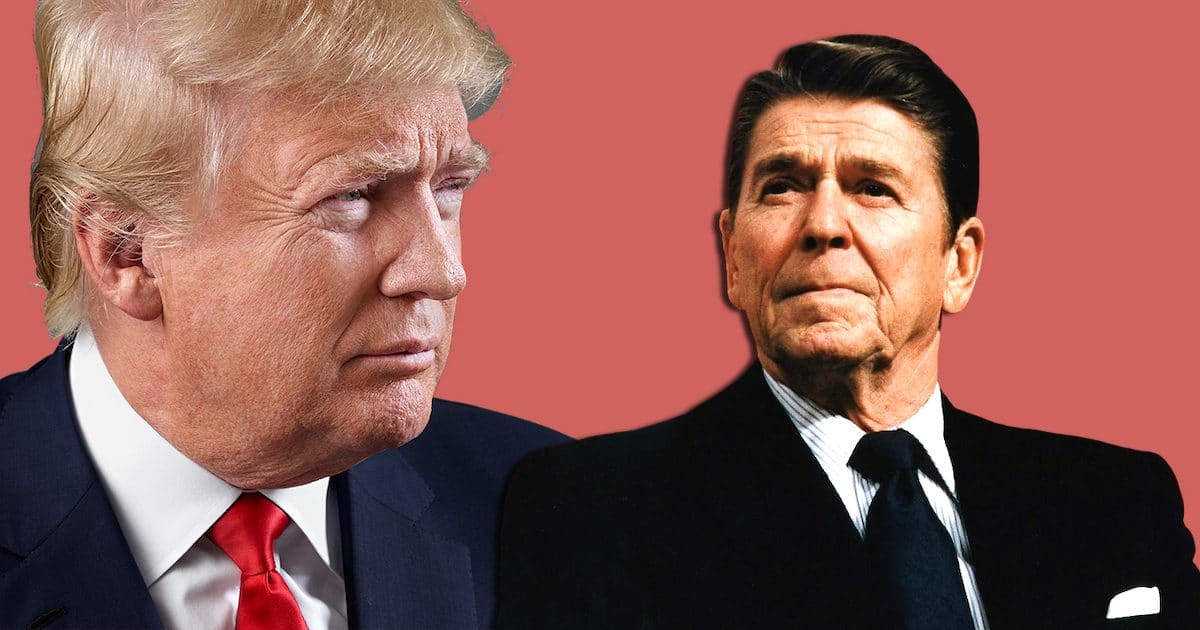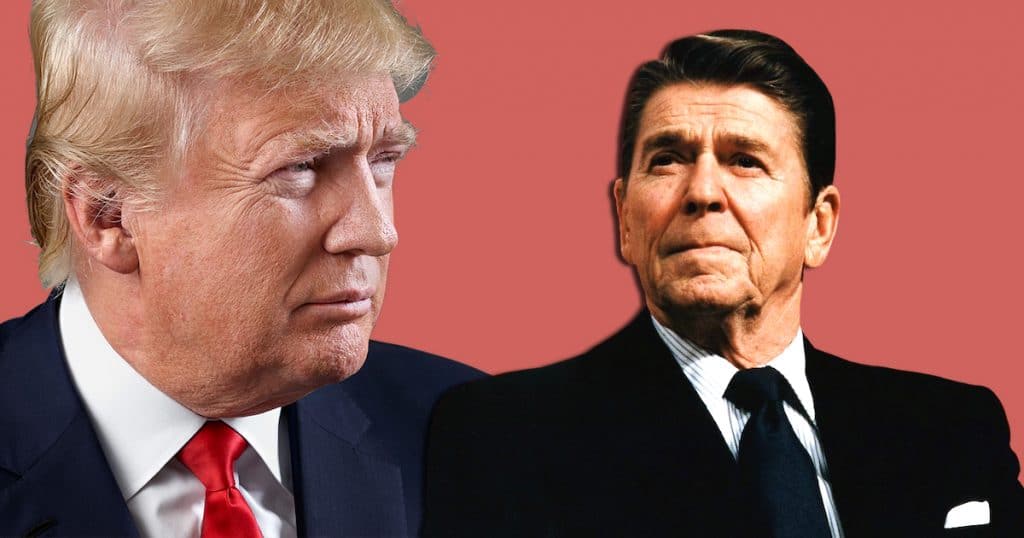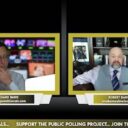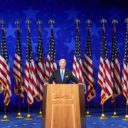

The Democrats were all over the news complaining about Donald Trump’s “rosy” economic forecasts, especially for growth in the American economy. Of course, we heard for three years that the current growth we had could not be obtained, or that Trump would need a “magic wand” to bring back the astounding number of manufacturing jobs he indeed has.
This all sounds so familiar. Let’s see, where did we hear this before? Oh yeah! In the Reagan years.
If there is a word that should be banned from pundit and Democrat talking points, it’s “rosy. When Ronald Reagan submitted his budgets replete with substantial tax cuts in 1981, virtually all the economic “insiders” insisted that his forecasts were “rosy.” There was no way the American economy could recover, let alone reach the growth levels his team projected. In fact, the economy—as it did with Trump—began to turn around almost instantly. Business Outlook, in May 1981, reported that spending for durable goods and gross private domestic investment each had shot up a whopping 22%. Those were indicators of confidence, something that a genuine leader produces. Typical of this confidence was Armco Steel, one of America’s largest steel producers, which announced a plan for a $1.96 billion expansion after the inauguration.
But the most amazing thing of Reagan’s remarkable recovery is that even his team underestimated and under-projected growth rates!
That same month, May 1981, economist Jerry Jordan even sent Murray Weidenbaum, the chairman of Reagan’s economic advisors, a memo in which he cautioned that talking about realexpected declines in inflation might seem “Pollyannish to observers” but that real output growth was “much greater” than outside observers predicted. Sure enough, a month later, a compilation of GNP growth estimates by six universities and private firms showed they concluded the economy would growing by 6.5% over the next year.
Reagan’s projections in every case were lower than the outsiders” . . . on purpose. Marty Asher, who compiled the data from, among others, Wharton, Chase Econometrics, and Merrill Lynch, found that the real rate was “recently revised to 8.4%.” But Reagan went with the lower rate in public.
The same thing occurred with inflation estimates, and once again, complaints about a “rosy” forecast were flat wrong. By 1986, Reagan’s team publicly used a money velocity rate of 5.5% but internal estimates were a full two points lower. Those proved correct. As early as July 1981 Weidenbaum told Reagan to ignore the immediate numbers: the long-term rates were very good and “quite strong.” A glum Democrat Speaker of the House, Thomas P. “Tip” O’Neill moaned, “I’m getting the s*#t whaled out of me” by the President.
Even foreign leaders noticed the change immediately. Helmut Schmidt, the chancellor of the Federal Republic of Germany visited the Gipper in May 1981, and saw in America “a natioin of upswing and optimism,” whereas in Europe “pessimism reigns.”
But in the very short term, squeezing inflation and waiting for the investment to kick in rode to O’Neill’s rescue, temporarily blurring the big picture. The media, of course, loved it: “the New York Review of Books said a “stench of failure hangs over Ronald Reagan’s White House,” and Fortune claimed investors were “terrified” of the tax cut. (Later, even Time magazine—a reliable Reagan-hating publication—admitted that other media outlets had been overly “antagonistic” in their campaigns against the President. When Reagan’s budget director, David Stockman, betrayed the administration with complaints about the big deficits, the opposite was occuring. From late 1981 to 1982, most insiders thought Reagan had oversold the deficits, not the tax cuts, and many pointed out the deficits were not as harmful as even Dutch predicted.
All the while, Reagan’s support of Federal Reserve Chairman Paul Volcker and his crusade to squeeze out inflation remained firm. Indeed, members of Congress began discussing ways to impeach . . . Volcker! Most of Dutch’s staff agreed, saying “Volcker is killing us.” But the Gipper knew better. He had to tame inflation without sacrificing the tax cuts. And he did.
Unemployment soon gave way, followed by inflation, which was down to 5% by the end of 1981. The stock market crept upward. By the second quarter of 1982 the economy grew at a stunning 8.7% rate and whereas some forecasts had 1983 down for a 5% decline, instead over the next twelve months private sector investment shot up by over 23%. Virtually every projection Reagan made came true, with the exception of balancing the budget. And those “rosy” projections? The White House’s internal numbers were always closer to reality, and higher, than anything discussed in public. As the Gipper himself joked, “The best sign that our economic program is working is that they don’t call it Reaganomics anymore.”
What the overwhelming evidence from the Reagan Papers shows is a powerful rebuttal to the notion that Dutch “knew the tax cuts wouldn’t work.” At every turn, the Reaganites were understating real economic growth and lower inflation. It turns out the Gipper’s rosy projections weren’t rosy enough!







william chandelr / March 14, 2019
Where do you think $22,000,000,000,000 in DEBT came from?
I never understand why people think Reagan was a great conservative! Reagan started us on the slide of debt-death, preferring to use “credit cards” to hide his excess spending and shove the inflation/debt onto coming generations. The red ink rolled under Ronny like at no time after WWII. Yet, the party faithful totally ignored that for whatever reason I will never know. Reagan waged war on the Working People of America (1)Launching the war with his attack on unionization, firing the air-traffic controllers and (2) Introducing the concepts of low paid part-time and contract workers. Remember how Henry Ford introduced the concept that if you paid your people enough money, they would/could buy the products they were building? Well Reagan destroyed that concept, and brought us HERE, to THIS economic crash. Reagan was no “hero” who destroyed Communism. Reagan was a coward who HID the fact that the USSR was dead on it’s feet and collapsing. Reagan created fear in the People to get support for a wasteful looting of the Public Treasury by the Military Industrial Thieves. Finally, Reagan, the week after leaving office, ran over to Japan to collect at LEAST $6MILLION in “speaking fees” which was a nice term for BRIBE for keeping our markets open to the Japanese, and thus SELLING OUT American Workers. No, Reagan was not a great man, he was a Low Life Credit Card spendthrift.
Raygunomics…tax more and spend a whole lot more…that ol’ boy keeps getting resurrected…his true legacy is the beginning of “deficits don’t matter”…and a central/big gov’t can control the economy.
And another thing — america became a war mongering state on the day that an all volunteer military (another Reagan screwup) became a reality, in the aftermath of the VN war. Thus ensuring more riches for the WAR PROFITEERS
Raygun was the genesis person of criminal spending…sworn in with a trillion is debt…sworn out with four trillion…the most in percentage terms of any POTUS in history including the current dumbass.
There was a time when Government employee salaries were well below their private sector counterparts. To compensate, they were provided with generous benefit packages; including the retirement plans that are sinking so many cities today. Give us twenty years and we will take care of you for life. In the mid-80’s Reagan increased salaries to be competitive with the private sector; his argument was that good people were leaving the public sector for better paying private sector jobs. This “conservative” did NOTHING to adjust the benefit packages to bring them in line with the private sector.
http://www.rationalrevolution.net/articles/recession_cause.htm
/